This article was co-authored by Chris M. Matsko, MD. Dr. Chris M. Matsko is a retired physician based in Pittsburgh, Pennsylvania. With over 25 years of medical research experience, Dr. Matsko was awarded the Pittsburgh Cornell University Leadership Award for Excellence. He holds a BS in Nutritional Science from Cornell University and an MD from the Temple University School of Medicine in 2007. Dr. Matsko earned a Research Writing Certification from the American Medical Writers Association (AMWA) in 2016 and a Medical Writing & Editing Certification from the University of Chicago in 2017.
There are 10 references cited in this article, which can be found at the bottom of the page.
wikiHow marks an article as reader-approved once it receives enough positive feedback. In this case, 84% of readers who voted found the article helpful, earning it our reader-approved status.
This article has been viewed 119,637 times.
Gangrene is a serious condition and it is vital to get professional medical treatment for gangrene as soon as possible. The longer you wait to seek treatment for gangrene, the slimmer your chances of a full recovery will be. Doctors often treat gangrene by removing any dead tissue that formed as a result of the condition, administering antibiotics, and using other therapies, such as oxygen therapy and maggot therapy. Learn how gangrene is treated so that you will know what to expect while being treated for gangrene.
Steps
Getting Medical Help
-
1Seek medical attention if you think you have dry gangrene. Gangrene can result from skin problems or changes, or in some cases from of limb ischemia (blockage of the arteries to lower legs and feet). All types of gangrene require professional medical treatment. If you suspect that you have dry gangrene, even if it is a mild case, then you should call your doctor as soon as possible. Symptoms of dry gangrene include:[1]
- Dry and shriveled skin that sloughs off easily
- Bluish or blackish colored skin
- Cold, numb skin
- Pain (sometimes, but not always present)
-
2Go to an emergency room if you have wet gangrene. While all types of gangrene require swift medical treatment, wet gangrene is more likely to be accompanied by an infection, which can be difficult to treat if it gets into your blood. Injuries may also cause wet gangrene, so you may require immediate treatment for that reason as well.[2] Seek emergency medical treatment if you notice any of the following symptoms of wet gangrene:[3]
- Swelling and pain in the infected area
- Skin that has changed from red to brown to black
- Blisters or sores accompanied by a bad-smelling discharge (pus)
- Fever
- Feeling sick in general
- Crackling sound when you press on the affected area
Advertisement -
3Watch for severe symptoms. If you determine that you have gangrene, there are some symptoms may indicate that the gangrene has infected your blood, which requires immediate medical attention. If you notice any of the following symptoms, call 911 or go to an emergency room right away.[4]
- Low blood pressure
- Rapid heartbeat
- Difficulty breathing or shortness of breath
- A sudden change in body temperature
- Pain in your body
- A rash
- Confusion and/or light-headedness
- Cold, clammy, pale skin
Considering Treatment Options
-
1Take antibiotics and other medications as instructed. Your doctor may give you an intravenous antibiotic or instruct you to take antibiotics orally as part of your treatment. You may also be administered medications to regulate your blood sugar since blood sugar regulation and short term glycemic control improve long term outcomes when it comes to healing and preventing infection. Follow your doctor’s instructions for taking antibiotics and any other medications that your doctor prescribes to help treat your gangrene.[5]
- If you have side effects or feel like you do not need the medication anymore, call your doctor before discontinuing them.
- Do not stop taking antibiotics until you have taken the entire prescription. Otherwise, they may not be effective and the infection may be harder to treat in the future.
-
2Undergo wound debridement and irrigation. Wounds with devitalized tissue, contamination, or residual suture need debridement before any other work is completed. Irrigation is important in removing the bacterial load and removing loose material.
- In surgical debridement, a scalpel or scissors is used to remove devitalized tissue or unwanted debris.
- Enzymatic debridement involves applying various enzymatic agents to the wound.
-
3Undergo oxygen therapy. Sometimes oxygen therapy may be used to help promote healing of damaged tissues. For this treatment, you will be placed in a special chamber that is filled with oxygen. The concentration of oxygen will be much higher in this chamber than in the normal environment, which is thought to help you heal faster and more effectively.[6]
- Oxygen therapy may assist in wound healing and help to reduce the amount of tissue that needs to be amputated.[7]
- Oxygen therapy has also been found to be extremely useful in surgical wound infections involving the Clostridium species that cause “gas gangrene,” which is a form of gangrene that develops inside the body.[8]
-
4Consider other therapies. Biologic therapy such as maggot therapy has been used to treat ulcers, chronic venous ulcers, diabetic ulcers, and other acute and chronic wounds. Recombinant human growth factors are now being examined as potential treatments for wound management. These factors include platelet-derived growth factor, fibroblast growth factor, and granulocyte-macrophage colony-stimulating factor. Your doctor may recommend trying one of these treatments to promote healing.
- Try to keep an open mind about maggot therapy. Sterile, lab-raised maggots are often used to treat gangrene. Because maggots will only eat dead tissue, they can be applied to the affected tissues and allowed to eat away the dead skin. This process can also help your body to heal itself and help to prevent infection.[9]
-
5Discuss amputation with your doctor. Surgery may also be required to remove the affected tissues from your body. If not removed, the gangrene is likely to spread and cause further harm to the rest of your body and possibly even death. Therefore, it may be necessary for your doctor to remove a finger, toe, foot, or limb in order to treat the gangrene.[10]
- Keep in mind that even when interventions are successful to open up an artery and reestablish blood flow to the affected area, surgical removal of dead tissues is still used for gangrene in almost every case.
-
6Treat the condition that is causing gangrene to develop. Causes of gangrene include diabetes, atherosclerosis of the limbs, peripheral artery disease, smoking, trauma, obesity, and Raynaud's Disease. It may be necessary to treat the underlying condition with medication or surgery in order to restore normal blood flow to the affected tissues and improve your future health. Discuss treatment options with your doctor.[11]
Expert Q&A
-
QuestionMy dad has gangrene, and now the doctor says a finger cut is required. Is there any other solution?
 Chris M. Matsko, MDDr. Chris M. Matsko is a retired physician based in Pittsburgh, Pennsylvania. With over 25 years of medical research experience, Dr. Matsko was awarded the Pittsburgh Cornell University Leadership Award for Excellence. He holds a BS in Nutritional Science from Cornell University and an MD from the Temple University School of Medicine in 2007. Dr. Matsko earned a Research Writing Certification from the American Medical Writers Association (AMWA) in 2016 and a Medical Writing & Editing Certification from the University of Chicago in 2017.
Chris M. Matsko, MDDr. Chris M. Matsko is a retired physician based in Pittsburgh, Pennsylvania. With over 25 years of medical research experience, Dr. Matsko was awarded the Pittsburgh Cornell University Leadership Award for Excellence. He holds a BS in Nutritional Science from Cornell University and an MD from the Temple University School of Medicine in 2007. Dr. Matsko earned a Research Writing Certification from the American Medical Writers Association (AMWA) in 2016 and a Medical Writing & Editing Certification from the University of Chicago in 2017.
Family Medicine Physician Sometime is best to amputate a small portion of the finger in order to save the limb. It does not hurt to get a second opinion in theses matters; however, if he has diabetes this can be very serious.
Sometime is best to amputate a small portion of the finger in order to save the limb. It does not hurt to get a second opinion in theses matters; however, if he has diabetes this can be very serious. -
QuestionHow long must I take antibiotics for my gangrene?
 Chris M. Matsko, MDDr. Chris M. Matsko is a retired physician based in Pittsburgh, Pennsylvania. With over 25 years of medical research experience, Dr. Matsko was awarded the Pittsburgh Cornell University Leadership Award for Excellence. He holds a BS in Nutritional Science from Cornell University and an MD from the Temple University School of Medicine in 2007. Dr. Matsko earned a Research Writing Certification from the American Medical Writers Association (AMWA) in 2016 and a Medical Writing & Editing Certification from the University of Chicago in 2017.
Chris M. Matsko, MDDr. Chris M. Matsko is a retired physician based in Pittsburgh, Pennsylvania. With over 25 years of medical research experience, Dr. Matsko was awarded the Pittsburgh Cornell University Leadership Award for Excellence. He holds a BS in Nutritional Science from Cornell University and an MD from the Temple University School of Medicine in 2007. Dr. Matsko earned a Research Writing Certification from the American Medical Writers Association (AMWA) in 2016 and a Medical Writing & Editing Certification from the University of Chicago in 2017.
Family Medicine Physician Antibiotics for gangrene are usually given via IV, given the nature of the disease. You are usually hospitalized for IV treatment. The doctor will determine how long this is necessary.
Antibiotics for gangrene are usually given via IV, given the nature of the disease. You are usually hospitalized for IV treatment. The doctor will determine how long this is necessary.
Warnings
- Do not attempt to treat gangrene on your own. Gangrene will only get worse without professional medical interventions. Seek medical attention if you think you have any type of gangrene.⧼thumbs_response⧽
- Always follow up with your PCP or ER physician as need for wound management and gangrene of ischemic limbs.⧼thumbs_response⧽
References
- ↑ https://www.nhs.uk/conditions/gangrene/symptoms/
- ↑ hhttps://www.hopkinsmedicine.org/health/conditions-and-diseases/gangrene
- ↑ http://www.webmd.com/skin-problems-and-treatments/guide/gangrene-causes-symptoms-treatments?page=2
- ↑ http://www.webmd.com/skin-problems-and-treatments/guide/gangrene-causes-symptoms-treatments?page=2
- ↑ https://www.news-medical.net/health/Diagnosis-and-treatment-of-gangrene.aspx
- ↑ https://www.nhs.uk/conditions/gangrene/treatment/
- ↑ http://www.ncbi.nlm.nih.gov/pmc/articles/PMC1114115/
- ↑ http://www.ncbi.nlm.nih.gov/pubmed/11292638
- ↑ https://pubmed.ncbi.nlm.nih.gov/9153871/
About This Article
If you think you might have gangrene, call your doctor immediately or go to an emergency room. To recognize dry gangrene, look for dry and shriveled skin that is bluish or black, cold to the touch, and numb. You may also feel some pain. Always seek emergency care for wet gangrene, which comes with swelling and pain in the infected area, blackened skin, sores with bad-smelling discharge, and a fever. You might also notice a crackling sound if you press on the area. You should also go to the emergency room if you have severe symptoms such as a rapid heartbeat, difficulty breathing, light-headedness, a sudden fever or chills, or a rash. For advice from our Medical co-author on how to get medical treatments for gangrene, such as antibiotics or surgery, keep reading.
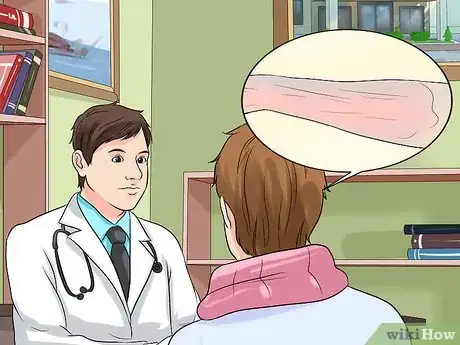
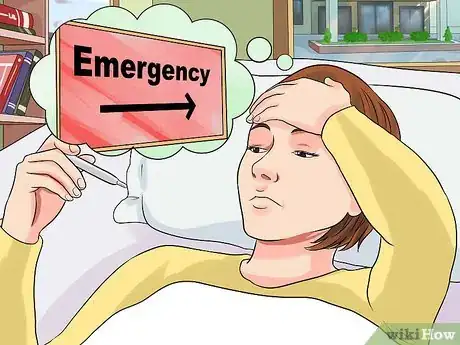

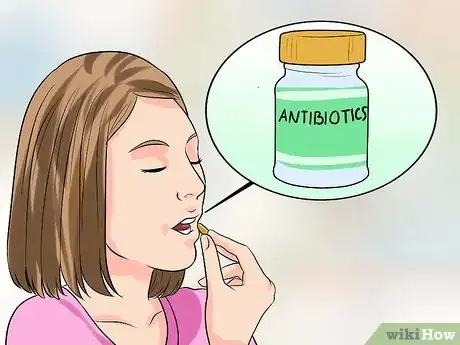
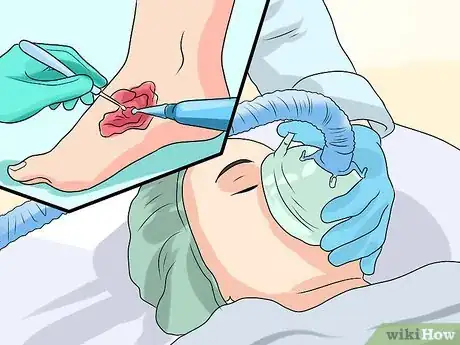
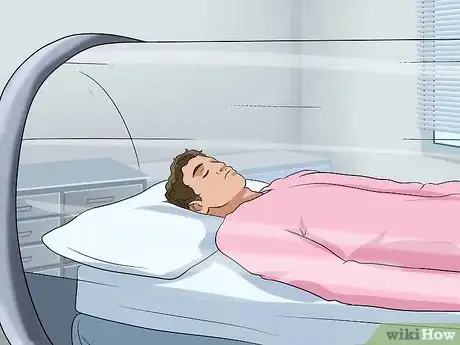
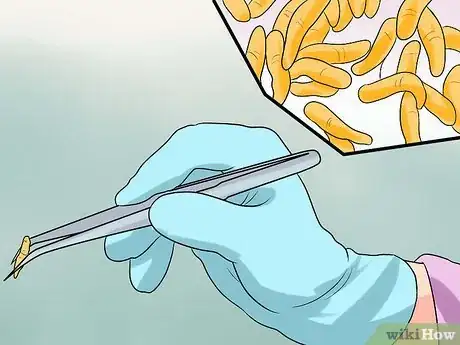
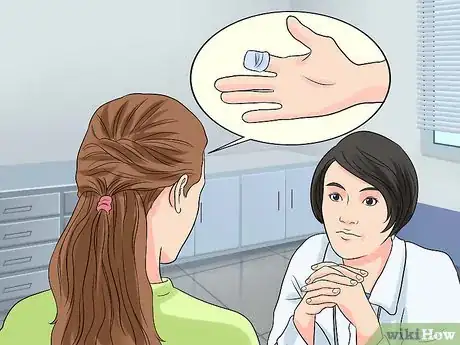

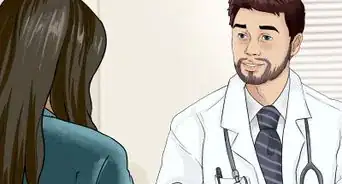



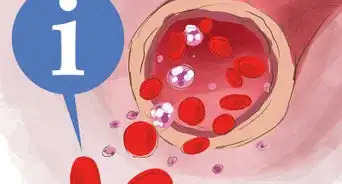
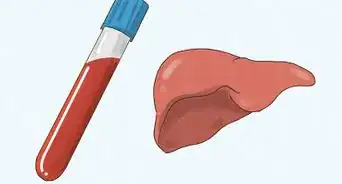

-Step-14-Version-2.webp)



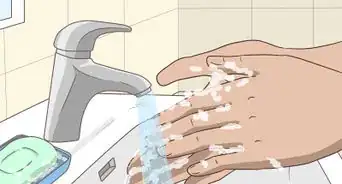
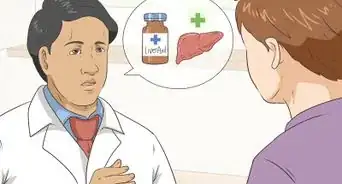











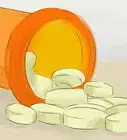





































Medical Disclaimer
The content of this article is not intended to be a substitute for professional medical advice, examination, diagnosis, or treatment. You should always contact your doctor or other qualified healthcare professional before starting, changing, or stopping any kind of health treatment.
Read More...